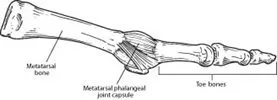What Is Capsulitis of the Second Toe?
Capsulitis of the second toe is a condition that affects the ligaments surrounding the joint at the base of the second toe. These ligaments form a capsule that plays a vital role in the proper functioning of the toe joint. In capsulitis, these ligaments become inflamed, most commonly impacting the second toe, although it can occur in the third or fourth toes as well. This inflammation causes significant discomfort and, if left untreated, can lead to the weakening of surrounding ligaments, potentially resulting in toe dislocation. Capsulitis is also known as dislocation syndrome and can occur at any age.
Causes of Capsulitis of the Second Toe
Capsulitis of the second toe is generally attributed to abnormal foot mechanics, where excessive weight-bearing pressure is placed on the ball of the foot beneath the second toe. Numerous factors may contribute to this heightened pressure, such as:
- Severe bunion deformity.
- A second toe longer than the big toe.
- Structural instability in the foot’s arch.
- Tight calf muscles.
Symptoms of Capsulitis of the Second Toe
Early recognition and treatment of capsulitis are essential because it is a progressive disorder that worsens if left untreated. In its early stages, symptoms may encompass:
- Pain, particularly in the ball of the foot, which may feel like there is a foreign object in the shoe or a bunched-up sock.
- Swelling in the affected area, typically at the base of the toe.
- Difficulty wearing shoes.
- Pain when walking barefoot.
As the condition progresses, the supporting ligaments weaken, causing the toe to become unstable and drift towards the big toe. Eventually, it can cross over and rest on top of the big toe, leading to a condition known as crossover toe, which shares the same symptoms as the earlier stages of capsulitis. The progression of the toe crossover can occur gradually or more rapidly due to injury or overuse.
Diagnosis of Second Toe Capsulitis
Accurate diagnosis is crucial as the symptoms of capsulitis can mimic those of a condition known as Morton’s neuroma, which requires different treatment. To determine the diagnosis, a thorough examination by a foot and ankle surgeon is essential. This examination involves assessing the foot, applying pressure, and maneuvering it to replicate the symptoms. The surgeon will also investigate potential causes and assess joint stability. X-rays are typically ordered, and additional imaging studies may be necessary in some cases.
Non-Surgical Treatment
Effective treatment for capsulitis of the second toe is most successful during the early stages before the toe begins to drift toward the big toe. During this phase, non-surgical approaches can stabilize the joint, alleviate symptoms, and address the underlying cause of the condition.
The foot and ankle surgeon may recommend one or more of the following non-surgical treatment options for early-stage capsulitis:
- Rest and Ice: Resting the foot and applying ice packs can help reduce swelling and alleviate pain. To apply ice, use a thin towel between the ice and the skin and apply it for 20 minutes, followed by a 40-minute break before reapplying.
- Oral Medications: Nonsteroidal anti-inflammatory drugs (NSAIDs), such as ibuprofen, may be prescribed to relieve pain and reduce inflammation.
- Taping/Splinting: In some cases, taping the affected toe to maintain its correct position may be necessary. This can help alleviate pain and prevent further toe drift.
- Stretching: Patients with tight calf muscles may be advised to perform stretching exercises to improve flexibility.
- Shoe Modifications: Supportive shoes with stiff soles are recommended as they can control motion and reduce pressure on the ball of the foot.
- Orthotic Devices: Custom-made shoe inserts, including arch supports or metatarsal pads, can distribute weight away from the affected joint and provide substantial relief.
When Is Surgery Needed?
Once the second toe starts moving toward the big toe, it will not return to its normal position without surgical intervention. The foot and ankle surgeon will determine the most suitable procedure or combination of procedures based on the individual patient’s needs.
Why Choose a Foot and Ankle Surgeon?
Foot and ankle surgeons are the foremost experts in foot and ankle care today. As doctors of podiatric medicine, they possess extensive education and training specific to the foot and ankle, surpassing that of any other healthcare provider. Foot and ankle surgeons are qualified to treat all foot and ankle conditions. Ranging from simple to complex, in patients of all ages, including capsulitis of the second toe. Their comprehensive training equips them to perform a wide array of surgeries, including those necessary for capsulitis of the second toe.






